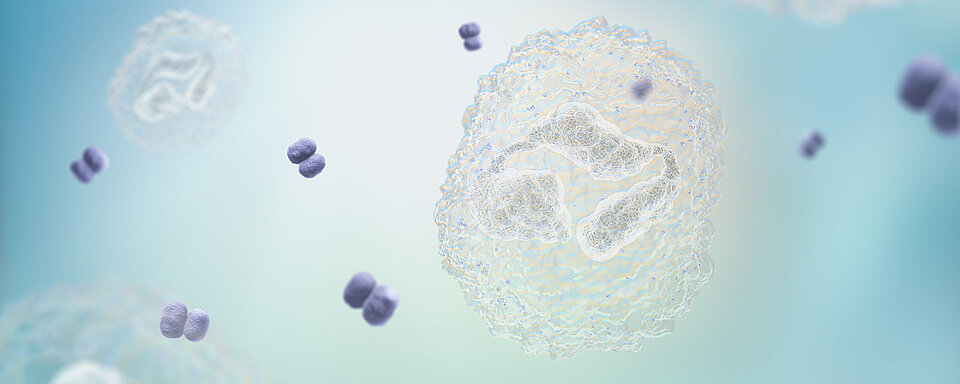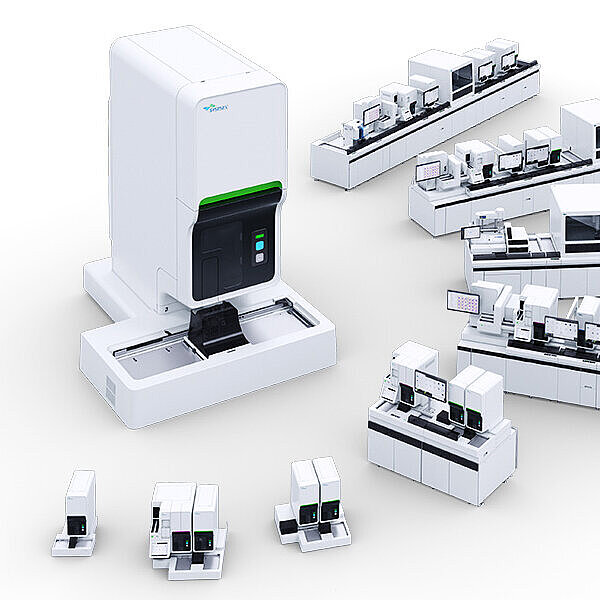Body fluids
Body fluid analysis covers several analytical disciplines. This includes counting and differentiating cells and other particles. Counting and differentiating cells from a range of different body fluids, such as cerebrospinal fluid, serous fluids, and synovial fluid, is possible with our haematology analysers (XN-Series and XN-L Series) and urine flow cytometers (UF-4000, UF-5000). The counting and differentiation of cells in body fluids is one important aspect in the process of finding the right diagnosis. There are various reasons for requesting this type of analysis, depending strongly on the type of body fluid.
Automating these processes for body fluids has several advantages compared to manual methods using a traditional counting chamber. Since it does not require any pre-treatment or preparation of the sample, analysis is fast and convenient. Its quality does not depend on subjective operator skills, so it is an appropriate way of standardising the procedure. And the number of time-consuming manual chamber counts can be reduced.
Because of the quick degradation of cells in body fluids, especially neutrophils, one should analyse the sample as quickly as possible.
Cerebrospinal fluid (CSF)
Cerebrospinal fluid is a clear, physiological saline body fluid with low protein content derived from ultrafiltration of the blood. It fills the space between the skull, brain and ventricles and surrounds the spinal cord. It serves as a ‘cushion’ for the brain and spinal cord, transports hormones and neurotransmitters, helps to remove toxic metabolites and ensures the brain has a constant milieu. A healthy adult usually has around 100 to 150 mL of this special fluid, and daily production is normally around 500 mL.
Cellular analysis of cerebrospinal fluid is requested to detect or exclude diseases affecting the central nervous system: infection by bacteria, viruses, fungi, or protozoans; inflammation, e.g. multiple sclerosis, or Guillain-Barré syndrome; leptomeningeal spread, i.e. cells from a peripheral tumour.
Samples are mostly taken by lumbar puncture and occasionally by cisternal puncture. In patients with a ventricular shunt, e.g. after surgery or during treatment of a hydrocephalus, samples can also be obtained from the shunt. Although a routine procedure, CSF sampling still bears some risks and makes CSF a precious material.
The counting and differentiation of cells found in cerebrospinal fluid supports distinguishing between different types of diseases. As a rule of thumb, more than 5 white blood cells/µL are considered pathological in adults, while in neonates up to 30 white blood cells/µL can occur in normal samples. A strongly elevated WBC count together with an increased number of polymorphonuclear cells is often indicative of bacterial infection. The predominance of mononucleated cells rather hints towards viral, tuberculous or fungal meningitides or inflammatory processes.
Pleural fluid
Pleural fluid accumulates between the two pleural layers, the space surrounding the lungs known as the pleural cavity. The physiological volume of pleural fluid is no more than 15 mL. Excessive amounts of this fluid (pleural effusion) are considered pathological. There are various reasons for such accumulation that range from congestive heart failure (most frequent reason) to pneumonia, pulmonary emboli or tuberculosis, etc.
In combination with biochemical parameters, the counting and differentiation of cells in pleural fluid can contribute to identifying the cause of the pleural effusion. Large numbers of neutrophils may, for example, suggest an infection, but even non-infectious pleural effusions may contain considerable numbers of white blood cells, although there may be more mononucleated cells in this case. In addition, mesothelial cells are commonly seen, and with an underlying oncological disease one can find tumour cells. If the fluid is bloody, this is most frequently due to trauma or cancer invasion.
Peritoneal fluid
Peritoneal fluid, which is found in the peritoneal cavity, is a clear, light yellow fluid with a volume of less than 50 mL. If the fluid has accumulated in excessive volume, it is known as ‘ascites’. The fluid is then commonly referred to as ‘ascitic fluid’ rather than ‘peritoneal fluid’. In most cases, ascites is due to liver cirrhosis, but it can also occur in cancer, congestive heart failure, and even tuberculosis. Analysis of peritoneal fluid is performed to identify the cause of the presence of the fluid and to detect or exclude peritonitis.
A polymorphonuclear cell count of ≥ 250/μL confirms the diagnosis of spontaneous bacterial peritonitis (SBP) in the absence of an evident intra-abdominal source of infection and the treating physician should immediately initiate empirical antibiotic treatment.
Synovial fluid
Synovial fluid is a clear, physiological body fluid of light yellow colour located inside the joint cavity that reduces friction between the articular cartilages during movement. There are many reasons for an increase in volume, and usually effusions are categorised into non-inflammatory, inflammatory, septic and haemorrhagic. The cell count and differentiation can help distinguishing inflammatory from infectious causes of the effusion. Very high white blood cell counts (more than 100,000/μL are possible) with a predominance of polymorphonuclear cells are suggestive of an infection of the joint.
Continuous Ambulatory Peritoneal Dialysis (CAPD) fluid
Continuous ambulatory peritoneal dialysis (CAPD) fluid is not a genuine body fluid because it neither occurs physiologically nor due to a disease itself – it is due to the treatment of a disease. The CAPD process is an alternative to haemodialysis for patients suffering from kidney diseases. It uses the patient's peritoneum as a membrane across which fluids and substances are removed from the blood by osmosis. The procedure harbours the risk of contracting a peritonitis through the catheter access. The special condition of ‘eosinophilic peritonitis’ is often seen due to patients’ allergic reactions to some components of the dialysis fluid or the connection systems mainly in the beginning of CAPD treatment. Increased white blood cell counts with a high percentage of polymorphonuclear cells can indicate peritonitis. Eosinophilic peritonitis is defined by the presence of WBC > 100/μL, with eosinophils constituting > 10% of the total white blood cell count.





